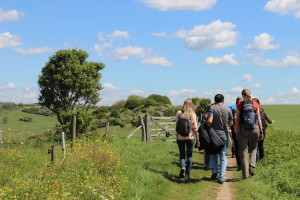 By Melissa Leach, IDS Director
By Melissa Leach, IDS Director
The STEPS Centre Summer School has been running here at IDS over the last two weeks – 38 fantastic PhD students and early career researchers from 25 countries. As ever we’ve all been enriched, enlightened and challenged by presentations, discussion and searching debate around building pathways to sustainability and social justice in an ever-more complex world. But the highlights, as in previous years, have been the two walkshops.
What’s a walkshop? Anyone who works in the international development field – whether as a researcher, policymaker or practitioner – inevitably spends lots of time in workshops. Some are creative, refreshing and productive. Others are less so. A walkshop basically takes a workshop outside and on the move, with, as we’ve found, some astonishing benefits.
Workshopping in the open
The walkshop idea came to us through colleagues in Norway. There it generally involves harsh weather, snow and ice, steep slopes and rocks – get your crampons on. The toughness is apparently part of the team-building point. In Sussex, my STEPS Centre colleagues and I have taken a gentler approach, profiting from the beautiful rolling South Downs and the (sometimes) kind early summer weather.
We choose a topic and start with a short lecture in the IDS building – this year ‘Uncertainty’, led by Andy Stirling, and ‘Futures, scenarios and pathways’ led by John Thompson and Ben Ramalingam. We put five or six questions for discussion on laminated cards, and then set out on a pre-defined route. People are encouraged to walk – or wander – in loosely forming groups, discussing a question and then swapping cards or shifting groups when a line of thought or interaction has run its course.
The landscape helps inspire conversation – as for instance thoughts about ecosystem and livelihood futures are triggered by grazing sheep and National Park signboards in a complex grassland/woodland ecology. And the landscape shapes interactions, as a narrow path confines an intimate discussion to the pair of walkers who can fit on it; as re-grouping at a gate or stile encourages new groups to form, and as an open clearing invites us to sit down and take collective stock. On most walkshops we have several stops like this, and finish with a plenary round-up of our thoughts and conclusions, several hours from the start, usually over a pub lunch or picnic.
The interactional and inspirational benefits of walking
Hierarchies diminish in a walkshop. The all-too common classroom/boardroom dynamic in which contextual seniors – the professors, the official experts – speak first and most, and others defer to them, gives way to a much more egalitarian sharing and appreciation of reflections and experiences. Similarly, some of my most insightful fieldwork conversations as an anthropologist in West Africa have happened when away from the formal dynamic of an interview, I’ve been walking to and from fields, fishing ponds or markets with groups of women or men.
We and others have found that ideas flow more freely in a walkshop than they would around a table in a room. People are more inclined to ‘think outside the box’, and come up with fresh and radical insights and innovations.
Science now backs this anecdotal evidence of the inspirational benefits of walking. An article by Stanford University researchers published last month in the Journal of Experimental Psychology finds a person’s creative output to increase by an average of 60 percent when walking.
Walks also have a long history in inspiring struggles for social justice. In 1930 Mahatma Ghandi’s Salt March (Salt Satyagraha) became a key part of the Indian independence movement. In South Africa, an annual Gandhi-Luthuli Salt March now pays homage to Gandhi and to Chief Albert Luthuli, South Africa’s first Nobel Peace Prize winner; a public event in which all people are invited to walk together to show their solidarity with the principles of Ubuntu, non-violence and peace.
In India, Anil Gupta, founder and leader of the Honey Bee Network, has pioneered walks to discover and gain inspiration from innovation at the grassroots. The Shodh Yatra involves farmers, scientists and researchers taking a week to walk together across rural India to unearth, share and disseminate local innovations and approaches to issues like conservation, organic farming, health and nutrition.
Walking – luxury or opportunity?
Is walking as an intellectual pursuit a luxury? Certainly, not everyone can walk easily; there are physical challenges which mean some classroom sessions and judicious transport to plenaries needs to be part of inclusion in a walkshop for some.
And for many people in the world, walking long distances is such a necessity – collecting fuel or water, getting to work, market, school, health centres or town – that the idea of a walking workshop might seem quite mad. As a rural villager, or field development practitioner, the ‘development workshop experience’ is at least partly defined by the opportunity to sit, for once, in a room, and talk around a table like officials and ‘experts’ are seen so often to do.
Yet as a wealth of experience in participatory development has shown, sitting in a room is far from the best way to get people thinking and interacting. The participatory development repertoire includes a vast variety of tools and techniques to overcome communication barriers, and help people appreciate and inspire each other’s ideas.
Is it time to recognise walkshops more fully as part of this repertoire? And to get academics and bureaucrats, as well as practitioners, into the open?
- This post first appeared on Melissa Leach’s Transforming Development blog
- Blog by Nathan Oxley On the benefits of walking and talking
- Resources: STEPS Centre Summer School 2014